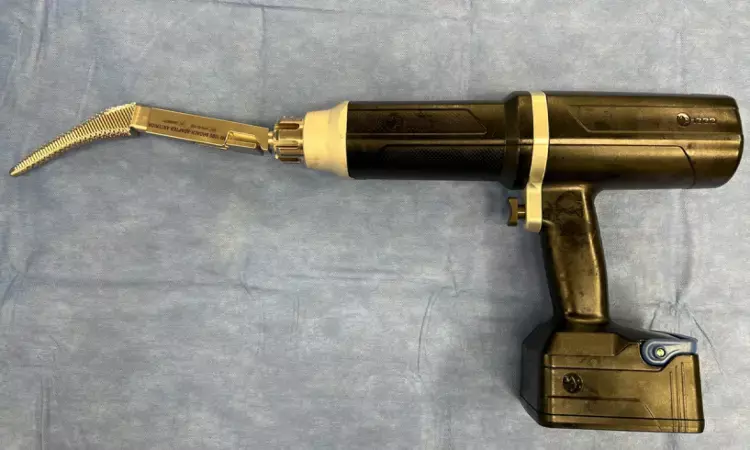- Home
- Medical news & Guidelines
- Anesthesiology
- Cardiology and CTVS
- Critical Care
- Dentistry
- Dermatology
- Diabetes and Endocrinology
- ENT
- Gastroenterology
- Medicine
- Nephrology
- Neurology
- Obstretics-Gynaecology
- Oncology
- Ophthalmology
- Orthopaedics
- Pediatrics-Neonatology
- Psychiatry
- Pulmonology
- Radiology
- Surgery
- Urology
- Laboratory Medicine
- Diet
- Nursing
- Paramedical
- Physiotherapy
- Health news
- Fact Check
- Bone Health Fact Check
- Brain Health Fact Check
- Cancer Related Fact Check
- Child Care Fact Check
- Dental and oral health fact check
- Diabetes and metabolic health fact check
- Diet and Nutrition Fact Check
- Eye and ENT Care Fact Check
- Fitness fact check
- Gut health fact check
- Heart health fact check
- Kidney health fact check
- Medical education fact check
- Men's health fact check
- Respiratory fact check
- Skin and hair care fact check
- Vaccine and Immunization fact check
- Women's health fact check
- AYUSH
- State News
- Andaman and Nicobar Islands
- Andhra Pradesh
- Arunachal Pradesh
- Assam
- Bihar
- Chandigarh
- Chattisgarh
- Dadra and Nagar Haveli
- Daman and Diu
- Delhi
- Goa
- Gujarat
- Haryana
- Himachal Pradesh
- Jammu & Kashmir
- Jharkhand
- Karnataka
- Kerala
- Ladakh
- Lakshadweep
- Madhya Pradesh
- Maharashtra
- Manipur
- Meghalaya
- Mizoram
- Nagaland
- Odisha
- Puducherry
- Punjab
- Rajasthan
- Sikkim
- Tamil Nadu
- Telangana
- Tripura
- Uttar Pradesh
- Uttrakhand
- West Bengal
- Medical Education
- Industry
Automated impaction in primary THA safe technique for femoral preparation resulting in consistent stem coronal alignment

While automated impaction can provide a more standardized process for femoral canal preparation, little is known regarding its effect on femoral component sizing and position.
Hope S. Thalody et al conducted a study to directly compare femoral component canal fill ratio (CFR) and coronal alignment between primary total hip arthroplasty (THA) procedures performed with automated impaction versus manual mallet impaction.
A retrospective analysis was performed on 184 patients who underwent primary THA by a single arthroplasty surgeon with a modern cementless femoral component using either the direct anterior or posterolateral approach. The final cohort was divided into 2 groups based on impaction technique during broaching: automated (N = 122) or manual (N = 62). A propensity score match was used to match for age, body mass index, sex, high versus standard offset stem, and preoperative femoral bone quality. Radiographic review was performed to measure intramedullary prosthetic CFR and coronal alignment.
Key findings of the study were:
• The automated cohort trended toward the use of a larger stem (5.67 versus 4.82, P = .006) and had a larger CFR at all 4 levels within the proximal femur (P = .004).
• The automated cohort had a more valgus and reliable coronal alignment (-0.57 (SD 1.50) versus -0.03 (SD 2.17) degrees, P = .03) and significantly shorter operative time (mean 78 versus 90 minutes, P < .001).
• There were no intraoperative or postoperative periprosthetic fractures in either cohort.
The authors concluded that - “Automated impaction in primary THA is a safe technique for femoral preparation which resulted in consistent stem coronal alignment, optimized canal fill within the proximal femur, and reduced operative times without increasing the risk of peri prosthetic fractures compared to manual broaching. The authors feel that automated impaction is a safe and effective technology for improving operating room efficiency and optimizing preparation of the femur.”
Further reading:
Does Automated Impaction Improve Femoral Component Sizing and Alignment in Total Hip Arthroplasty?
Hope S. Thalody, Zachary D. Post et al
The Journal of Arthroplasty 2023
https://doi.org/10.1016/j.arth.2023.04.054
MBBS, Dip. Ortho, DNB ortho, MNAMS
Dr Supreeth D R (MBBS, Dip. Ortho, DNB ortho, MNAMS) is a practicing orthopedician with interest in medical research and publishing articles. He completed MBBS from mysore medical college, dip ortho from Trivandrum medical college and sec. DNB from Manipal Hospital, Bengaluru. He has expirence of 7years in the field of orthopedics. He has presented scientific papers & posters in various state, national and international conferences. His interest in writing articles lead the way to join medical dialogues. He can be contacted at editorial@medicaldialogues.in.
Dr Kamal Kant Kohli-MBBS, DTCD- a chest specialist with more than 30 years of practice and a flair for writing clinical articles, Dr Kamal Kant Kohli joined Medical Dialogues as a Chief Editor of Medical News. Besides writing articles, as an editor, he proofreads and verifies all the medical content published on Medical Dialogues including those coming from journals, studies,medical conferences,guidelines etc. Email: drkohli@medicaldialogues.in. Contact no. 011-43720751


